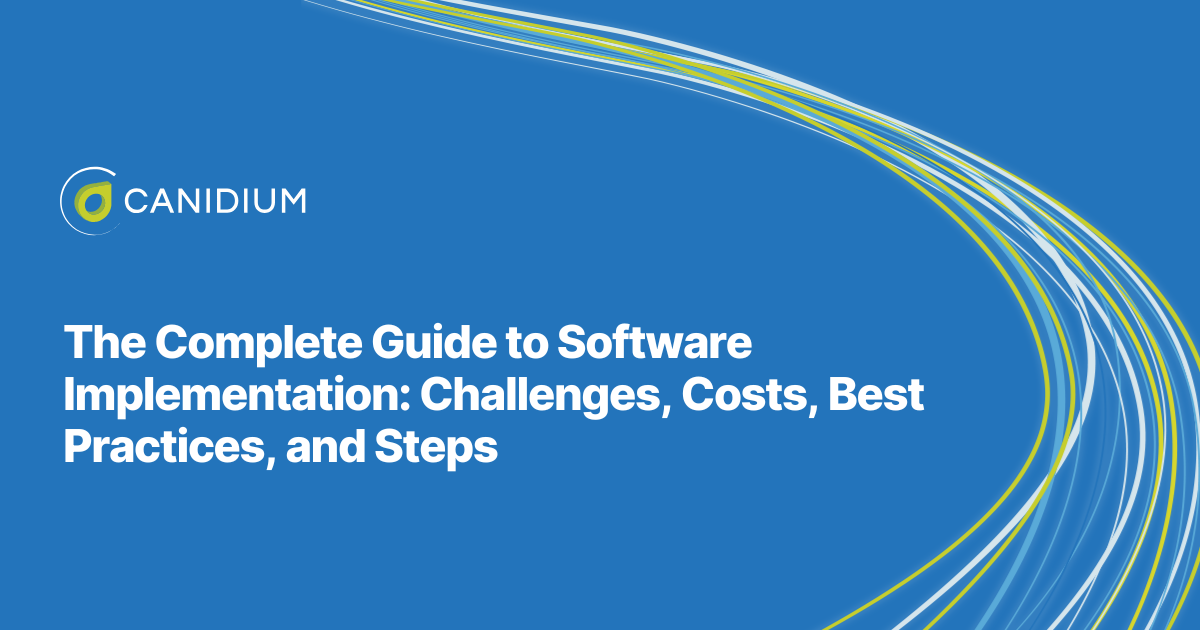Managing successful projects is not always an easy or straightforward task. There are hundreds of moving parts to oversee, and project managers often have to overcome unexpected hurdles along the way. Consequently, the project's success may depend on how well you prepare ahead of time.
At Canidium, our software implementation teams routinely oversee large-scale and complex projects. Based on this experience, we have developed the following tried and tested strategies for project preparation:
- The Most Common Project Management Challenge
- Bringing Together Key Stakeholders: How to Create Your Project Team
- Carving Out Your Timeline: How to Prepare for Each Project Task
- Practicing Effective Project Management: How to Prepare Your Infrastructure and Coordinate Resources
The Most Common Project Management Challenge
While each project will produce its own challenges and obstacles, there is one overarching roadblock to managing successful projects that many teams encounter: overburdened project managers.
The project manager's role is essential. They are responsible for the team's overall success. Put simply, they have a controlling influence over outcomes, directly impacting ultimate ROI. Consequently, when your project manager is stretched thin, your project is less likely to achieve maximal value.
Research backs the importance of project management to outcomes. Organizations that undervalue project management experience a 50% higher project failure rate.
Consider the diverse responsibilities a project manager typically shoulders—coordinating with stakeholders, managing timelines, overseeing budgets, and ensuring alignment with project goals. Now, imagine compounding these responsibilities with additional roles that may not align directly with the core competencies required for effective project management. All too often, this is a recipe for stress, stifling productivity and creating inefficiency that could jeopardize the entire project.
When project managers are overtasked, their ability to focus sharply on any single aspect diminishes. Each role added to their plate spreads their attention thinner, leading to potential oversights and decreased quality of work.
Moreover, the stress of juggling multiple roles can lead to burnout. Beyond the individual health and wellness implications of workplace stress, a burned-out manager is less likely to provide the support and leadership their team needs, which can create a ripple effect, spreading disengagement among team members.
Burnout has a direct impact on workforce productivity. According to the 2021 Work and Well-being Survey by the American Psychological Association, which polled 1,501 adult workers in the U.S., nearly 60% of employees cited negative consequences of work-related stress, such as a decrease in interest, motivation, or energy (26%), and a reduction in effort at work (19%).
The data is clear: One person cannot be responsible for a project's success. Instead, the most effective way to improve project outcomes is to establish stronger project teams.
Bringing Together Key Stakeholders: How to Create Your Project Team
Successfully managing a project involves much more than just following a checklist; it requires a balanced team of dedicated professionals who understand their roles and are committed to achieving the project's goals. Clear role definitions and allocating adequate resources to these key positions are critical to prevent task overload and ensure efficient project execution.
To avoid the consequences of overburdening your project manager, you will need to develop a strong project team. The following roles are foundational to a successful business project. When developing your team, start by filling out this blueprint:
.png?width=1920&height=1080&name=2016%20Auction%20of%20the%20largest%20collection%20of%20Memphis%20designs%20(1).png)
Project Manager
First and foremost, you will need an experienced project manager. They will play a critical role in steering the project toward success.
The project manager's responsibilities extend beyond mere coordination; they are tasked with managing timelines, budget allocations, and resource distribution. Effective project management requires maintaining a clear view of the project's objectives while managing the expectations of all stakeholders involved. They will ensure that every team member is aligned with the project goals and that deliverables are met on schedule, all while navigating potential risks and making strategic adjustments as needed.
Product Owner
The product owner is a strategic role that guards the project's objectives. They are responsible for defining the scope of the project deliverables and ensuring that they align with the strategic business goals.
This role involves prioritizing features, managing the product backlog, and making critical decisions that influence the project's direction. The Product Owner's ability to effectively communicate with technical teams and business stakeholders is crucial in bridging the gap between vision and execution.
IT Lead
Regardless of your business project, you will likely need some level of adjustment to your digital infrastructure. Most projects today require extensive configurations and integrations because organizations are in the process of digital transformation. For instance, software implementations are a common project organizations are initiating.
Because many business processes are managed digitally, you will need to include an IT lead on your project team, especially if you are undergoing a software upgrade or solution implementation.
The IT lead is in charge of addressing the technical challenges that come with the project. Their role involves overseeing the IT infrastructure and ensuring that all technical resources are leveraged efficiently to meet the project's needs. This includes managing software and hardware deployments, ensuring data security standards are met, and collaborating with technical subject matter experts to propose innovative solutions. Their leadership is key in ensuring that the technical strategy aligns with the project goals and that any technical issues are resolved swiftly to avoid impacting the project timeline.
Executive Sponsor
Building buy-in at the executive level is vital for successful project outcomes. The Executive Sponsor is crucial for the high-level support and visibility of the project within the organization. In this role, they provide strategic direction, secure essential resources, and champion the project across executive teams. Their involvement is vital for overcoming bureaucratic hurdles and facilitating smooth decision-making processes. The Executive Sponsor's commitment to the project reassures the team and stakeholders of the project's priority and alignment with the organization's strategic goals.
Technical Subject Matter Experts
Regardless of what your project goals are, you will need to leverage the expertise of technical subject matter experts (SMEs). They bring specialized knowledge that is crucial for the execution of the project.
Their expertise allows them to address specific challenges with precision and propose solutions that optimize performance and efficiency. Working closely with the IT Lead and Product Owner, your SMEs will help ensure that technical solutions are not only feasible but also robust and aligned with the broader business objectives. You will find their insights are essential for troubleshooting complex issues and innovating new approaches that enhance project outcomes.
Carving Out Your Timeline: How to Prepare for Each Project Task
Effective project management not only involves coordinating tasks and managing resources but also requires a meticulous approach to timing and commitment from team members. Here's how to ensure that every part of your project runs as smoothly as possible by understanding the dynamics of full-time versus part-time commitments, and establishing a well-defined project timeline.
Facilitate Full-Time Dedication
If your project team has too much on their plate, your outcomes will likely reflect the lack of resources dedicated to the effort. More specifically, you may see the following impacts:
- Missed Goals and Deadlines: When team members split their time between multiple projects or responsibilities, it can lead to mismanaged priorities and missed deadlines. Partial commitments often result in delayed deliverables as team members may not be available when needed to push the project forward.
- Increased Stress and Burnout: Juggling multiple responsibilities can increase stress levels for team members. Over time, this stress can lead to burnout, reducing overall productivity and potentially leading to higher turnover.
- Communication Breakdowns: Part-time commitments can disrupt the flow of information, leading to communication gaps. These gaps might cause misunderstandings or errors that could have been avoided with more consistent team interaction.
Ideally, you should schedule your project to encompass the majority of your team's focus during the process. This will not only reduce the total timeline of the project but it will also bring the following benefits:
- Increased Focus and Productivity: Team members dedicated full-time to a project can focus their entire workday on project tasks, leading to higher productivity and more consistent progress. This focused approach minimizes distractions and allows for a deeper understanding of the project's intricacies, which enhances problem-solving and innovation.
- Streamlined Communication: Having full-time team members means communication can flow more freely, and issues can be addressed in real-time. This constant presence increases the team's ability to respond to project changes swiftly and efficiently.
- Enhanced Team Cohesion: Full-time commitment helps in building a stronger, more cohesive team dynamic. Team members are more likely to develop a shared understanding and work in harmony, which is crucial for navigating complex projects.
Tips on Carving Out Your Project Timeline
Beyond simply ensuring that your team has dedicated time to allocate to your project, you can increase your chances of a successful outcome by sticking to the following best practices:

- Define Clear Milestones: Start by outlining key project milestones and then break these down into smaller tasks. Each task should have a clear objective, an owner, and a deadline. This approach helps monitor progress and ensure accountability throughout the project lifecycle.
- Use Project Management Tools: Leverage tools like project management software to visualize the timeline and track the progress of tasks. These tools help adjust the timeline dynamically as the project evolves and can provide insights into resource allocation and potential bottlenecks.
- Allocate Buffer Time: Always include buffer time for critical tasks to accommodate potential delays. This is especially important in complex projects where dependencies might impact the timeline. Buffer time helps mitigate the risk of the entire project timeline being derailed by unforeseen issues.
- Regularly Review and Adjust the Timeline: The project timeline should not be static. Regular review meetings with the team can help identify any shifts in the project scope or external factors that might impact the timeline. Adjustments should be made proactively to keep the project on track.
- Prioritize Flexibility and Agility: While it's important to stick to a timeline, flexibility is equally critical. Being too rigid can cause setbacks when unexpected changes occur. Encourage a culture where agility is valued and where plans are adjusted to accommodate new information or changes in the project environment.
Practicing Effective Project Management: How to Prepare Your Infrastructure and Coordinate Resources
The exact steps you need to take to prepare your internal infrastructure for your project will vary, as each project is unique. However, regardless of the nuances of what your preparation looks like, there are several broad tasks you should initiate.
To begin with, assessing the existing infrastructure is critical; project managers need to evaluate if current hardware, software, data sets, and network capabilities meet the project's demands. If not, necessary upgrades or additions should be planned early to prevent delays. Opting for scalable solutions is essential since project scopes can evolve, necessitating infrastructure that can adjust accordingly without disruptions.
Security is another cornerstone of infrastructure preparation, especially as projects increasingly rely on digital tools. Implementing robust cybersecurity measures to protect project data against threats is paramount, alongside regular updates and strict security protocols to maintain the integrity of the project.
Before the project launch, a thorough testing of all infrastructure components, including stress tests and performance evaluations, should be conducted to ensure the system can handle the project's demands under various conditions.
On the resource coordination front, developing a comprehensive allocation plan is crucial. This plan should detail how human and material resources are distributed across different project phases, taking into account the skill sets of team members and the logistical needs of materials to optimize efficiency. Utilizing resource management software can aid significantly in this area.
Clear communication channels are vital for effective coordination, ensuring that all team members are consistently updated about their responsibilities and the status of resources. This should include regular meetings and progress updates.
Overcoming Hurdles and Managing Successful Projects
Effective project management requires assembling a dedicated team, where each member fully understands and commits to their roles, ensuring efficient project execution and preventing task overload.
Key roles such as the project manager, product owner, IT lead, executive sponsor, and technical subject matter experts must be clearly defined. The project manager should oversee not just coordination but also timelines, budget, and resource distribution. The product owner manages the product backlog, aligning deliverables with business strategies, while the IT lead adjusts digital infrastructure to support project needs. The executive sponsor secures resources and facilitates decision-making, and subject matter experts provide essential technical expertise.
Effective timeline management involves defining clear milestones, using project management tools for tracking, and including buffer times for critical tasks. Infrastructure preparation and resource coordination are crucial, requiring robust security measures and a comprehensive resource allocation plan. By integrating strategic planning with proactive execution, project managers can lead their teams to successful outcomes, adapting effectively to changing project demands.
Learn more about successful project management strategies here.








